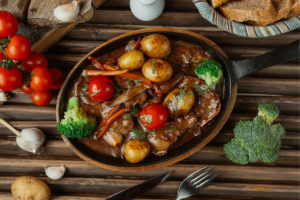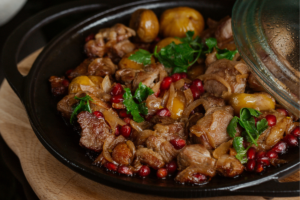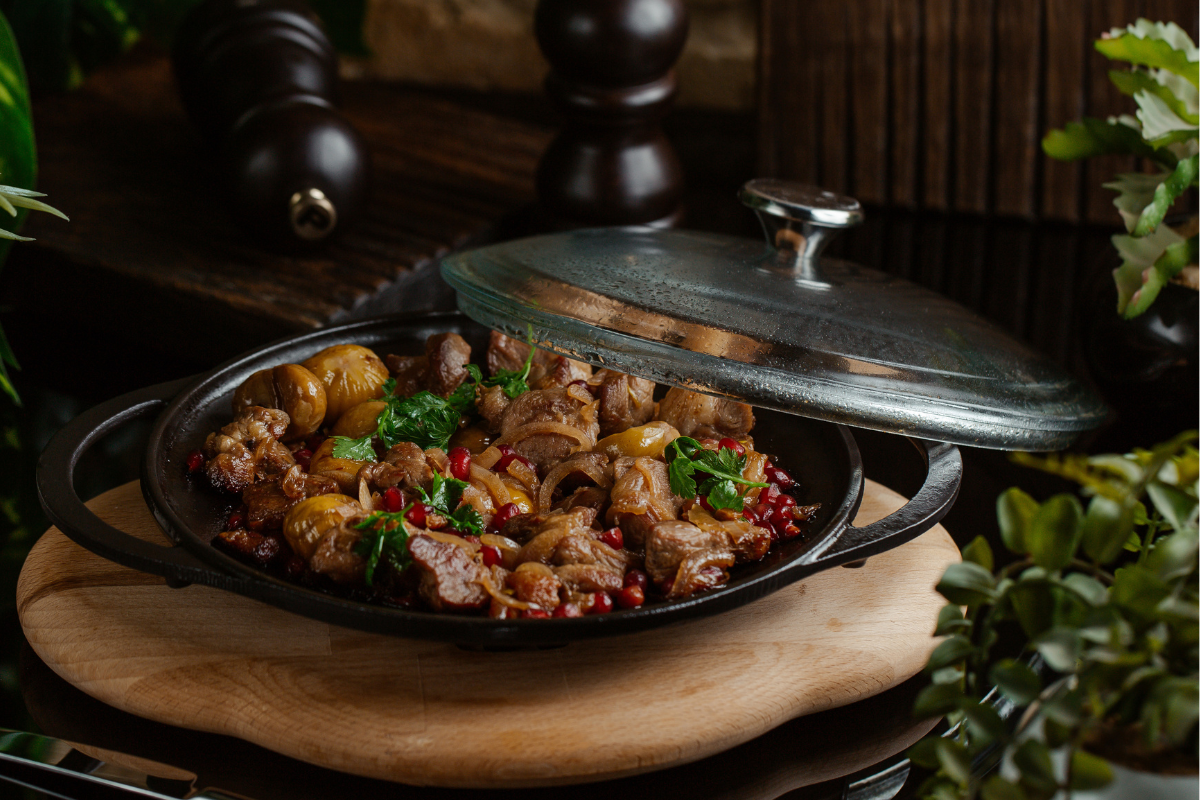Oxtails, once regarded as a humble cut of meat, have now gained recognition in various culinary traditions worldwide. These gelatinous and flavorful pieces of meat have a rich history, connecting cultural practices, economic factors, and culinary innovation. This exploration delves into the origins, evolution, and current significance of oxtails in the culinary world, answering the question: Where do oxtails come from?
Introduction: The Rise of Oxtails in Global Cuisine
The culinary world is vast, with each culture offering unique flavors and ingredients. Among these, oxtails have earned a special place. Known for their rich taste and succulent texture, oxtails are now a sought-after delicacy in many kitchens globally. Yet, before becoming a gourmet item, they were merely the tail of an ox or any cattle, often seen as a lower-tier cut of meat.
The journey of oxtails from butchery to the dining table is a tale of economic necessity, cultural adaptation, and gastronomic innovation. Today, we explore this journey, answering the fundamental question: Where do oxtails come from?
The Historical Origins of Oxtails
Understanding the significance of oxtails requires a look at their history. The term “oxtail” originated when oxen—castrated male cattle bred for labor—were the primary source of this meat. In the past, almost every part of the animal was used, leaving little to waste. The tail, though not highly regarded, became a source of sustenance for those with limited means.
In medieval Europe, especially in England, oxtails were common in stews and broths consumed by the working class. The tail, with its tough meat and bony structure, required long cooking times, making it ideal for slow-cooked dishes that were both nourishing and filling. As cattle farming spread globally, the use of oxtails followed, embedding itself in various culinary traditions.
Today, “oxtail” refers to the tail of any cattle, not just oxen. This broader definition reflects changes in agricultural practices and the meat industry, where efficiency and economy have become paramount.
Cultural Significance: Oxtails in Traditional Cuisine
The use of oxtails in cooking is deeply rooted in various cultures. For many, oxtails represent a connection to their heritage and a testament to culinary ingenuity.
Jamaican and Caribbean Cuisine
In Jamaica and the broader Caribbean, oxtails are highly valued. The dish “Jamaican Oxtail Stew,” often cooked with butter beans, is a staple in many households. This dish, featuring slow-cooked oxtails in a rich, savory sauce, shows how a humble cut of meat can be transformed into a culinary masterpiece.
The origins of this dish trace back to the days of slavery when people gave African slaves less desirable cuts of meat, including oxtails. Over time, they transformed these cuts into flavorful, hearty meals that are now integral to the region’s culinary identity.
African American Soul Food
In the United States, particularly in the South, people cherish oxtails as a key component of soul food, a cuisine rooted in the African American experience. Oxtail stew, often cooked with vegetables like carrots, onions, and potatoes, embodies the resourcefulness and resilience of African Americans throughout history.
Like Caribbean cuisine, the use of oxtails in soul food arose from necessity. During slavery and subsequent years of economic hardship, African Americans made do with what was available. Being a cheaper cut of meat, were often included in meals. Over time, these dishes became cherished family recipes, passed down through generations.
European and Asian Traditions
In Europe, particularly in the United Kingdom, it has been a traditional ingredient in soups and stews for centuries. The British dish “Oxtail Soup,” a slow-cooked, richly flavored broth with tender pieces of oxtail, is a classic example. Similarly, in Italy, coda alla vaccinara—a Roman oxtail stew—is a traditional dish enjoyed for generations.
In Asian cuisine, particularly in Korean and Chinese traditions, chefs use oxtails in soups and braised dishes. In Korea, cooks simmer oxtails for several hours to create a popular soup called kkori gomtang, which results in a nourishing broth believed to offer health benefits. Chinese cuisine, they often braise oxtails in soy sauce with spices, producing a tender and flavorful dish.
The Anatomy of an Oxtail: What Makes It Unique?

An oxtail is the culinary name for the tail of cattle, composed of several small vertebrae surrounded by meat and encased in a thick layer of cartilage. This structure gives oxtails their characteristic gelatinous texture when cooked, making them ideal for slow-cooked dishes.
Each section of an oxtail contains a central bone with marrow, surrounded by a layer of fat and meat. The high collagen content in the meat breaks down during cooking, imparting a rich, silky texture to dishes. This is why chefs favor oxtails in recipes that require long, slow cooking methods, such as braising or stewing.
Where Do Oxtails Come From Today?
Today, they can come from any breed of cattle, including cows and steers. Butchers typically cut the tail into sections, with each piece containing a portion of bone, marrow, and meat.
The Meat Industry and Oxtails
The process of sourcing oxtails has become more streamlined with advancements in the meat industry. Today, oxtails are available in most grocery stores and butcher shops, often packaged in small sections for convenience. The meat industry has adapted to the growing demand for oxtails, ensuring this once-overlooked cut of meat is readily available to consumers.
However, the rising popularity of oxtails has also led to an increase in price. Once a cheap cut of meat, people now consider oxtails a delicacy, commanding higher prices in both supermarkets and restaurants. This shift reflects a broader culinary trend, as chefs and consumers re-evaluate and appreciate lesser-known cuts of meat for their unique flavors and textures.
Sustainability and Ethical Considerations in Oxtail Consumption
As the demand for oxtails grows, so does the conversation around sustainability and ethical meat consumption. Oxtails, by their nature, are a byproduct of the meat industry. Since they come from a part of the animal that might otherwise go to waste, they represent a more sustainable option in meat consumption.
In an era where consumers are increasingly concerned about the environmental impact of their food choices, oxtails offer a way to enjoy meat while minimizing waste. Using every part of the animal, as people traditionally did, aligns with the principles of sustainable and ethical eating.
Nutritional Value: The Health Benefits of Oxtails
Oxtails are prized not only for their flavor but also for their nutritional content. They are rich in several key nutrients that contribute to a balanced diet. Here’s a breakdown of what offer:
- Collagen: they are particularly high in collagen, a protein essential for maintaining healthy joints, skin, and connective tissues. When slow-cooked, the collagen in oxtails breaks down into gelatin, adding a rich, silky texture to dishes and providing potential health benefits for joint and gut health.
- Protein: Like most cuts of meat, oxtails are a good source of protein, crucial for muscle repair, immune function, and overall body maintenance. The protein content makes oxtails a filling and satisfying addition to meals.
- Iron: Oxtails contain iron, an essential mineral that supports the production of hemoglobin in red blood cells, helping to transport oxygen throughout the body. Adequate iron intake is important for preventing anemia and maintaining energy levels.
- Fat: While oxtails are nutritious, they are also relatively high in fat, particularly saturated fat. For those monitoring their fat intake, it’s important to consume oxtails in moderation as part of a balanced diet.
Given their rich nutritional profile, oxtails can be a valuable addition to a health-conscious diet when prepared in a way that balances their fat content.
Oxtails in Modern Cuisine: From Rustic Stews to Gourmet Dishes

It has come a long way from being a simple ingredient in rustic stews. Today, they are celebrated in both home kitchens and gourmet restaurants for their deep flavor and versatility. The key to cooking it lies in slow, gentle cooking methods that allow the meat to become tender and the flavors to develop fully.
Popular Oxtail Dishes Around the World
- Jamaican Stew: A hearty dish that features oxtails slow-cooked with butter beans, carrots, and a blend of spices. The result is a rich, savory stew traditionally served with rice and peas.
- Korean Kkori Gomtang: A nourishing soup made by simmering oxtails with garlic and scallions. The long cooking time produces a broth that is rich in flavor and believed to have health benefits.
- Roman Coda alla Vaccinara: An Italian oxtail stew slow-cooked with tomatoes, celery, and a blend of herbs and spices. This dish is a staple of Roman cuisine, known for its robust flavor and tender meat.
- British Oxtail Soup: A traditional soup that features oxtails simmered with vegetables like onions, carrots, and leeks. Often, chefs thicken the broth with flour or a roux, creating a rich, velvety soup.
- Braised : In this gourmet dish, chefs sear the oxtails and then braise them in a mixture of wine, broth, and aromatic herbs until the meat becomes tender and falls off the bone.
These dishes highlight the versatility of oxtails and their ability to absorb and enhance the flavors of the ingredients they cook with. Whether in a simple stew or a complex braised dish, oxtails bring a unique depth of flavor to the table.
The Rising Popularity and Cost
As it has grown in popularity, particularly in gourmet circles, their price has risen significantly. What was once an affordable cut of meat is now a premium item in many markets. This increase in cost can be attributed to several factors:
- Increased Demand: As more people discover the rich flavor and culinary potential , demand has surged, particularly in high-end restaurants and among food enthusiasts.
- Limited Supply: Each animal provides only one tail, inherently limiting the supply . This scarcity drives up the price, especially in markets where demand is high.
- Labor-Intensive Preparation: To prepare it for sale, butchers perform significant work by cutting the tail into sections and properly trimming it. This additional labor contributes to the overall cost.
Despite the higher price, many people are willing to pay for the unique taste and texture that offer. People now view them as a delicacy, appreciating not only their flavor but also their role in traditional and modern cuisine.
(FAQs)
-
Why is it called oxtail if it’s not from an ox?
Historically, the term oxtail referred specifically to the tail of an ox. Over time, the definition has expanded to include the tails of all cattle, including cows and steers.
-
Is there a difference between oxtail and other tail meats?
Yes, oxtail specifically refers to the tail of cattle, which has a unique flavor and texture due to its high collagen content. Other tail meats, such as those from pigs or sheep, differ in flavor and cooking characteristics.
-
Are oxtails healthy to eat?
Oxtails are rich in protein, collagen, and iron, making them a nutritious option. However, they are also high in fat, so it’s important to consume them in moderation as part of a balanced diet.
-
How are oxtails prepared and cooked in traditional dishes?
Cooks typically slow-cook oxtails in stews, soups, or braised dishes to tenderize the meat and develop deep flavors. The long cooking time allows the collagen to break down, resulting in a rich, gelatinous texture.
-
Why have oxtails become so expensive?
The rise in popularity, coupled with the limited supply of oxtails, has driven up the price. Additionally, the labor-intensive preparation process adds to the cost.
Conclusion:
The story is one of transformation from a humble, overlooked cut of meat to a celebrated delicacy in kitchens around the world. Their rich history, cultural significance, and unique culinary qualities have earned them a place in both traditional and modern cuisine.
As we continue to explore new ways to enjoy and appreciate it. it’s important to consider the sustainability and ethics of our food choices. By embracing cuts of meat like oxtails, we honor the culinary traditions of the past and contribute to a more sustainable and responsible food system.
Understanding where oxtails come from and their journey through history allows us to appreciate this flavorful cut even more. Whether in a rustic stew or a gourmet dish, it offer a unique taste experience that connects us to the rich tapestry of global culinary traditions.
Learn more about the Oxtail Recipe: A Culinary Delight.

